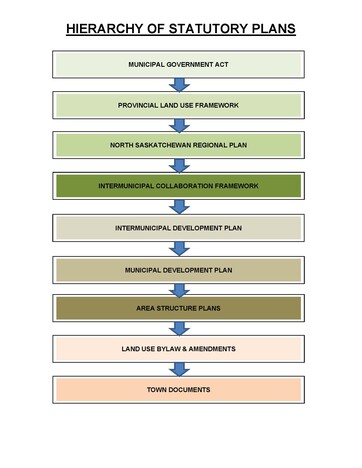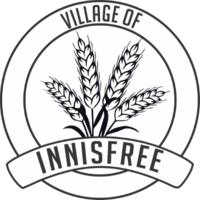
Land use planning in Alberta must follow plans at both the Provincial and Municipal levels of government.
With the implementation of the Provincial Land Use Framework and the Alberta Land Stewardship Act, some planning decisions will be made at the regional level as well. Land use may also be subject to other federal and provincial regulations.
The list below, with links, outlines the Village of Innisfree's hierarchy of Land Use planning decisions:
The Municipal Government Act (MGA) is the legislative framework in which all municipalities across the Province of Alberta operate. It provides the governance model for municipalities and lays the foundation of how we function, including areas of planning and development.
The MGA identifies the hierarchy and relationship of statutory plans, so that each plan will be consistent with the plans above it and, in the event of an inconsistency, which provisions in what plan will prevail.
The Land-Use Framework (LUF) sets out an approach to managing the province's land and natural resources to achieve Alberta’s long-term economic, environmental and social goals. The LUF established seven new land-use regions and calls for the development of a regional plan for each.
North Saskatchewan Regional Plan
The regional plan sets out a new approach for managing the lands and natural resources to achieve the province's long-term environmental, economic and social goals.
The North Saskatchewan Region is located in central Alberta and has approximately 85,780 square kilometres, or just under 13 per cent of Alberta's total land base. The region is bordered by Saskatchewan to the east, British Columbia to the west, the Upper Athabasca and the Lower Athabasca regions to the north and the South Saskatchewan and Red Deer regions to the south (and includes the Village of Innisfree.) The region has a large and diverse landscape, which contains the Rocky Mountains, rolling foothills and prairie parkland.
Intermunicipal Collaboration Framework
The ICF is a tool to facilitate cooperation between neighbouring municipalities to ensure municipal services are provided to residents efficiently and cost effectively. The goal is to enable municipalities to collaborate regarding service delivery and cost-sharing.
Intermunicipal Development Plan
All municipalities sharing a common boundary, effective March 31, 2020 (for urban municipalities, and effective March 31, 2021 for rural municipalities) were required to adopt an IDP between the municipalities. An IDP is a statutory plan that establishes any conflict relating to planning activities within or around another Municipality; and, ensures orderly development by reducing unnecessary costs and negative impacts on either municipality.
The MDP is a statutory plan that establishes policies for land use and other matters for the entire municipality. It is a high level document that provides leadership and direction in the preservation of environmentally sensitive areas and provisions for the infrastructure necessary to encourage sustainable and economic development.
Local Area Structure Plan(s):
The LUB is a planning tool that helps implement the goals in the land use plans and regulates development within the Village. All parcels of land are divided into different districts; each district consists of development regulations and permitted or discretionary uses to be considered.
*Revised Land Use District Map
VILLAGE DOCUMENTS:
Land Use Bylaw Amendments
Other Pertinent Village Bylaws:
Regional Subdivision & Development Appeal Board Bylaw
Property Related Bylaws:
- Municipal Utilities:
Water & Wastewater Bylaw 618-16
Amending Water & Wastewater Bylaw 650-20
Solid Waste Management Bylaw 621-16
- Property Maintenance:
Unsightly Premises Bylaw 599-15
- Animal Control:
Village Development-Related Policies:
Commercial Development Incentive Policy
Commercial Development Incentive Application Form
Residential In-Fill Incentive Policy
Residential In-Fill Incentive Policy Application Form
Village Property-Related Policy:
Snow Removal Policy 3200-01 - Snow Removal Map
Snow Removal Policy 3200-01 - Liability Release Application
Permit/Applications Forms:
Village of Innisfree Development Permit
Land Use Bylaw Amendment Application
Permit Information:
The Village of Innisfree Land Use Bylaw requires that anyone who is building or demolishing any type of structure, to apply for and secure approval of a Development Permit prior to starting a project.
A Development Permit addresses such issues as restrictions pursuant to the Land Use Bylaw with regards to Zoning, setbacks, parking, etc.
A Building Permit addresses legislation under the Alberta Building Code with regards to construction, materials, etc., and provides inspection services to ensure the project complies with Provincial legislation.
The Village can advise or direct a Developer to a Safety Codes Officer on whether or not a project requires a Building Permit, which is facilitated by a registered Safety Codes Inspection Company in Alberta.
Development Permit Process:
A Development Permit is required prior to a Building Permit application. This applies to:
- any structure that exceeds 10.0 m2 (107.6 square feet);
- demolition or removal of any structure;
- moving in of any structure (i.e. mobile or Ready-to-Move (RTM) homes);
- a deck with a height of 0.6 m (2.0 ft.) or greater above grade;
- change of use of land or building;
- building alterations or additional building on a lot;
- any increase in the number of households occupying and living in any building or on any site, and any construction or alterations or additions that would provide for an increase in the number of households which could occupy and live in any building or on any site, including any increase in the number of dwelling units in a building or on a site;
- the removal of top soil from land; and,
- an excavation or stockpile and the creation of either of them.
A Development Permit requires the following information:
- a Site Plan showing the legal description; the front, rear and side yards, if any; any provision for off-street loading and vehicle parking; and access and egress points to the site;
- building dimensions;
- Description of the proposed development/project;
- Authorization from the Owner if applicant is not the Owner of the Property; and
- Contractor name and estimated cost of the development/project.
The Development Permit must be signed by an authorized Development Officer and issued to a Property Owner prior to the application of any of required Disciplines' Permits, (Building, Electrical, Plumbing Permits, etc.)
Please note: Development Permits require payment in full prior to application processing.
Note: It is the Property Owner's responsibility to locate the survey pins (boundaries) on/of their property.
All development within the Village of Innisfree must conform to Land Use Bylaw 628-17 and all Amending Land Use Bylaws, as listed above. Additional, detailed information is provided in the Land Use Bylaw.
Issuance of Development Permit:
The issuance of a Development Permit in accordance with the "Notice of Decision" provided by the Development Officer, is subject to the condition that it does not become effective until twenty-one (21) days after the date of issuance of the Notice of Decision.
This is to allow for any Person affected by the decision to be able to make an appeal, to the Subdivision and Development Appeal Board.
An appeal shall be made by serving a written notice of appeal and submitting the applicable fee to the Secretary of the Subdivision and Development Appeal Board within twenty-one (21) days after:
- the date the order, decision or permit issued by the Development Authority was publicized in accordance with the Land Use Bylaw (LUB); or,
- the forty (40) day period referred to in Section 4.3(7) of the LUB has expired.
This Permit would not become effective until the Subdivision and Development Appeal Board has determined the appeal; a Permit may be modified or nullified.
Permit Timeframe/Expiry:
If the Development authorized by a Permit is not commenced within twelve (12) months from the date of issuance, and completed within three (3) years of the date of issuance, the Permit is deemed to be void, unless an extension to this period is granted by the Development Authority.
SAFETY CODES PERMITS:
Building and Other Disciplines' Permits:
The Village of Innisfree utilizes registered Safety Codes companies for the Provincial permitting services.
Once a Development Permit has been approved the Owner/Contractor shall submit a copy of the Permit in conjunction with application(s) for the Building Permit and associated disciplines' permit(s) to an approved Safety Codes Council office.
Please check out approved SCO Agencies serving the Village of Innisfree HERE.
1. Superior Safety Codes Inc. - online application
Superior Safety Codes Inc. may be contacted Toll free: 1-866-999-4777
Email Superior Safety Codes Inc. for information: info@superiorsafetycodes.com
By Fax: 780-870-9036
2. The Inspections Group - online application
The Inspections Group may be contacted Toll Free: 1-866-554-5048
Email The Inspections Group for information: questions@inspectionsgroup.com
By Fax: 1-866-454-5222
3. IJD Inspections Ltd. - online application
IJD Inspections may be contacted Toll Free: 1-877-617-8776
Email the IJD Inspections Ltd. for information: permits@ijd.ca
By Fax: 403-347-2533
Always remember to think "Safety First" before a Development is commenced:
Locate Underground Services:
- Contact Utility Safety Partners (formerly Known as "Alberta One Call") and
- Submit a Locate Request online or,
- Phone: 1-800-242-3447
Check for Power Lines and your safety:
- Contact ATCO 1-800-668-2248, or
- Contact ATCO Online
If you are building a new house:
With the Government of Alberta's introduction of builder licensing on December 1, 2017, residential builders are required to have either a valid builder license or an Owner Builder Authorization in order to receive a Building Permit.
Owner builders constructing their own home can apply for an Owner Builder Authorization (OBA.) If an OBA application receives approval, an authorization certificate will be issued to the owner builder. The authorization allows owner builders to construct their own home, either with or without warranty.
Permit issuers are only able to provide the necessary permits if an authorization has been approved.
If you have any further questions, please contact program staff at:
- Via email: homewarranty.inquiries@gov.ab.ca
- Phone: 1-866-421-6929
The Builder Registry is an online source of information to search Alberta's licensed residential builders.
If you are Buying a new house:
Warranty coverage has been a requirement for every new home constructed in Alberta since February 1, 2014. The Property Registry allows prospective homeowners, builders, real estate professionals and financial institutions to search for:
- Warranty status of a property
- Information about which warranty provider is backing the property
- The commencement date of warranty coverage
Was the home built by a licensed builder? The Builder Registry allows homeowners, builders, real estate professionals and financial institutions to search for:
- Builder's License status
- Where the Builder has built homes
- The number of previous home warranty registrations
- If the Builder has any orders or administrative penalties issued under the new Home Buyer Protection Act and related Regulations.
